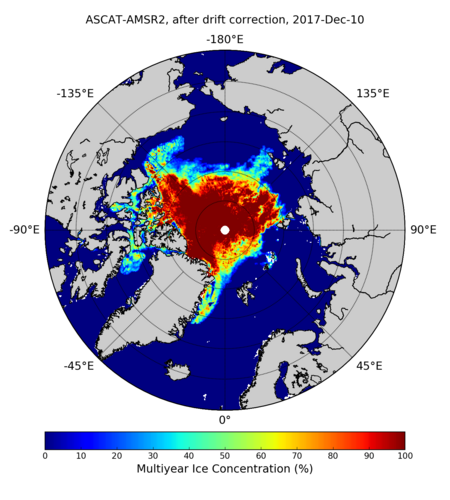
Multiyear Ice Concentration and Ice Type
Sea ice in the Arctic and Antarctic can be classified into several types, the main ones being
- young ice (YI): thin (up to 30 cm thick) new ice; includes a few sub-types; can be smooth or rough
- first-year ice (FYI): formed during one cold season; thickness above 30 cm,; surface can be levelled, rough or with ridges
- multiyear ice (MYI): ice that has survived at least one melt season;topographic features generally smoother than FYI
The physical properties of sea ice differ significantly for the different ice types. Therefore. knowledge of the sea ice type is important for a number of activities including marine navigation and modelling of the ice-ocean-atmosphere system, and also for remote sensing of other quantities related to sea ice such as the depth of the snow layer on top of it. With the recent accelerated decrease of MYI in the Arctic, mapping this ice type on a daily basis has become important for many applications
The MYI data on this site are from a new satellite-based retrieval of sea ice type which can in principle distinguish YI, FYI and MYI. This retrieval was originally developed for the Arctic and has recently been adapted for Antarctic conditions as well, in the project "SITAnt" (Sea ice type distribution
in the Antarctic from microwave satellite observations), funded by Deutsche Forschungsgemeinschaft (DFG), grant SP1128/2-1, in the framework of the Antarctic priority programme SPP~1158 "Antarctic Research with comparative investigations in Arctic ice areas''.
The retrieval method uses data from active and passive microwave instruments (radar scatterometer and radiometer, respectively), but then in addition applies several correction schemes to account for the effect of melt-refreeze processes, snow metamorphosis and sea ice drift on the sea ice type retrieval. Both air temperature and sea ice drift data are used in the corrections.
As the retrieval does not work during the melt season, the data record usually spans October to May. Even during the winter season, the retrieval can be problematic - see details here.
For more information see the MYI User Guide
Data Availability
Arctic Multiyear Ice data on site are currently available for the period listed below (but restricted to the cold seasons, usually October to April)
- Oct 2002 - today
Antarctic Multiyear Ice data are currently available for the period listed below (but restriced to the cold seasons, usually February to October.
- February 2013 - today
For details, see "Information" on the left panel.
See "Data Access" on the left panel for data download options.



 Start
Start